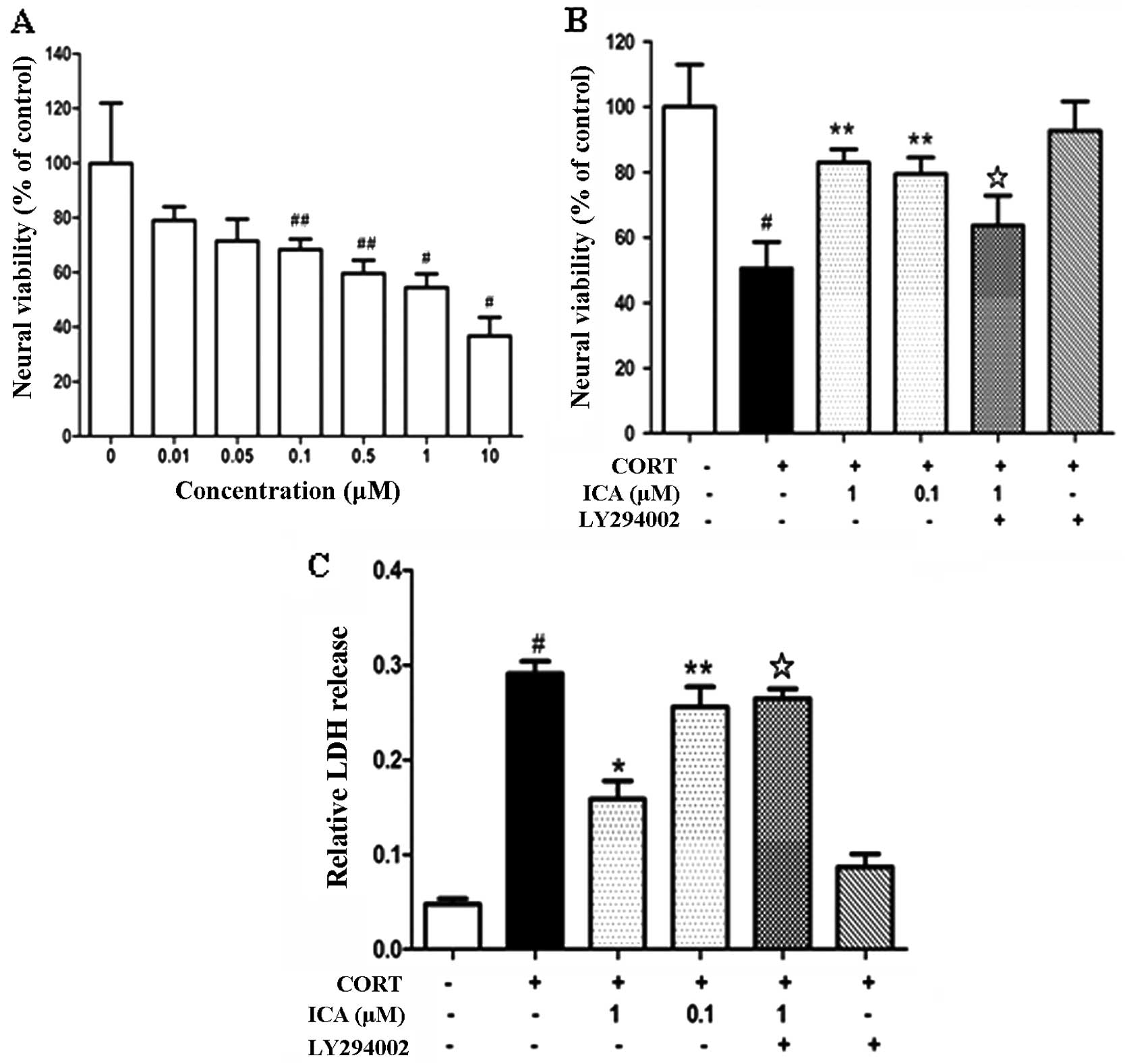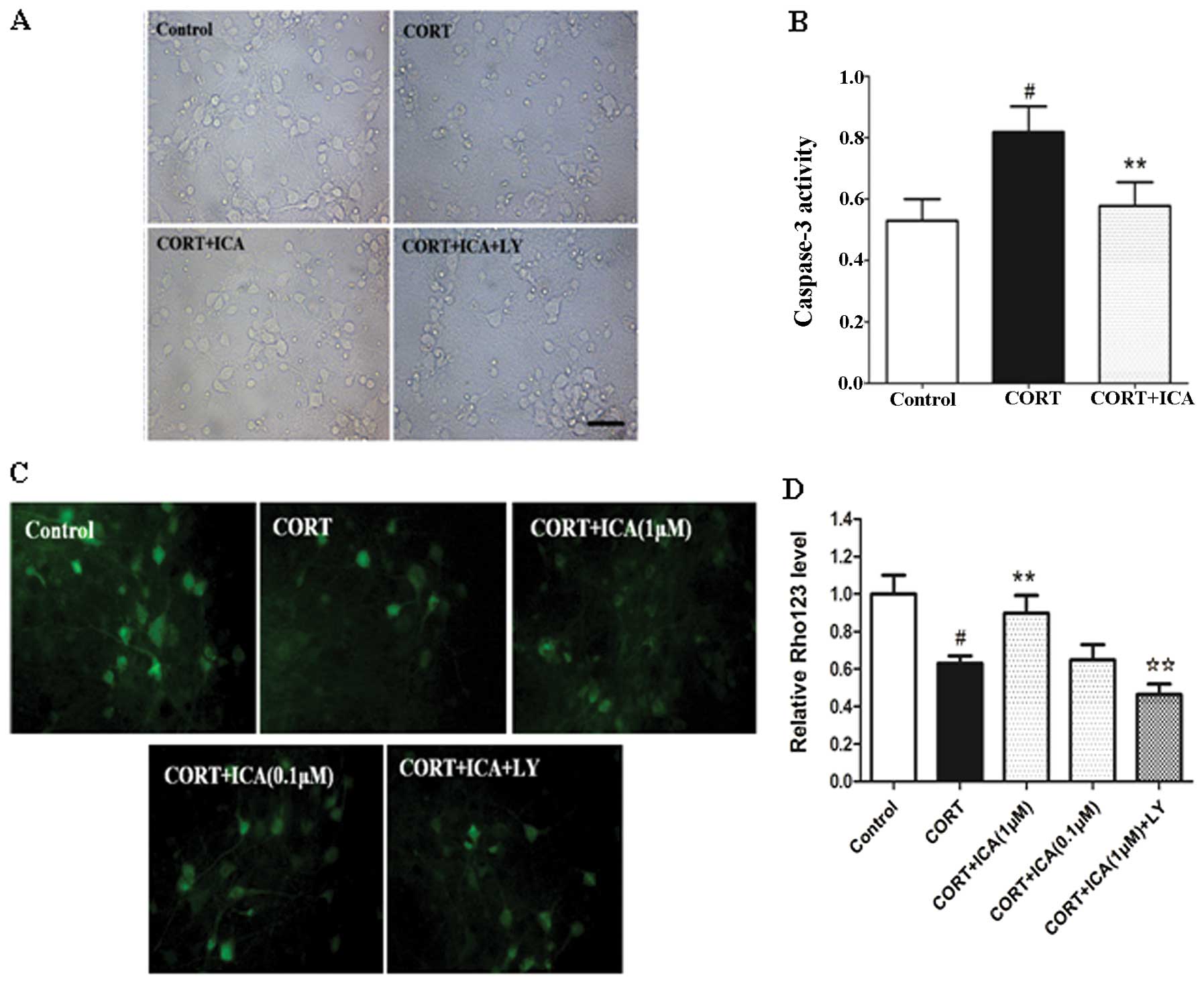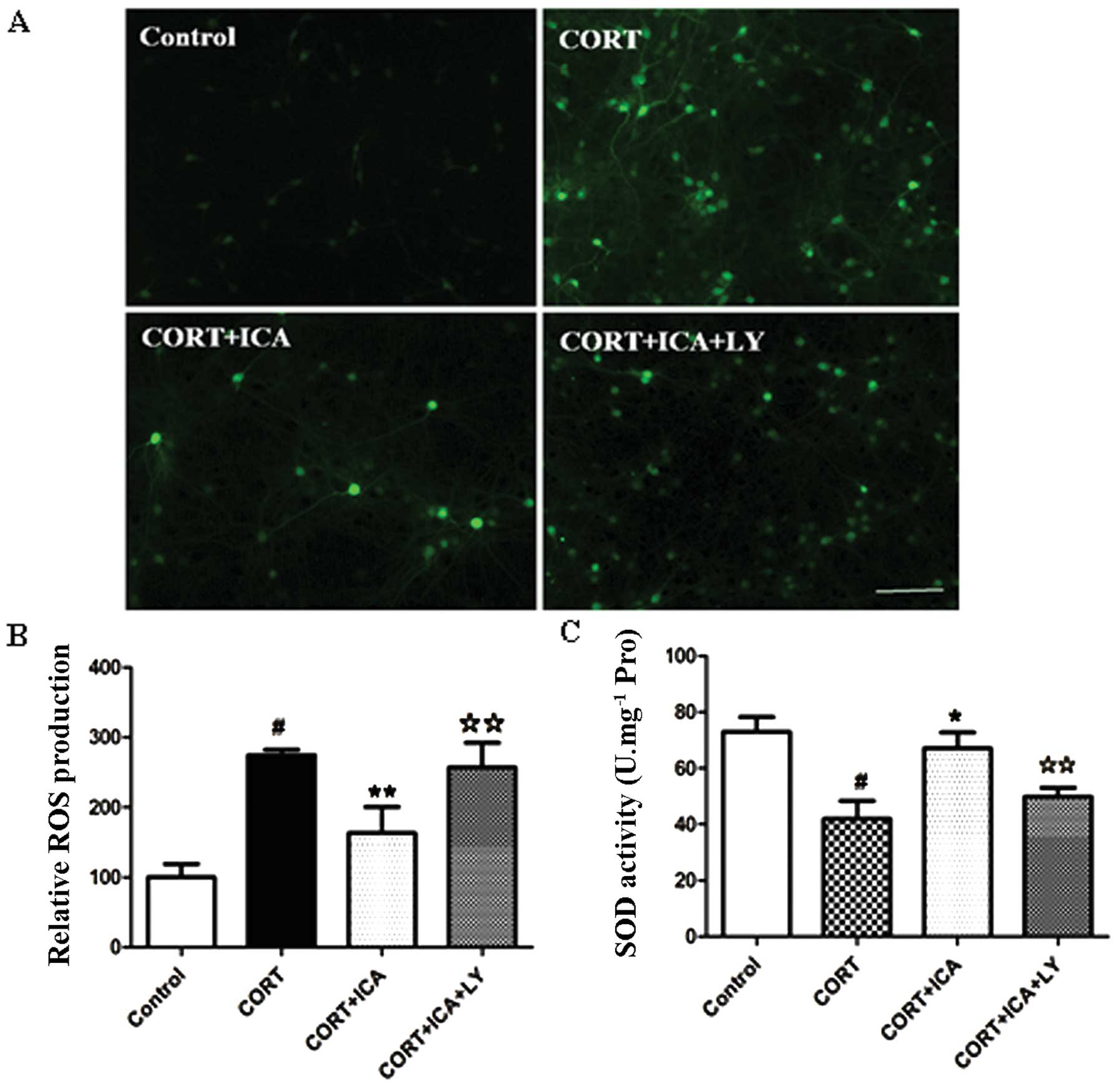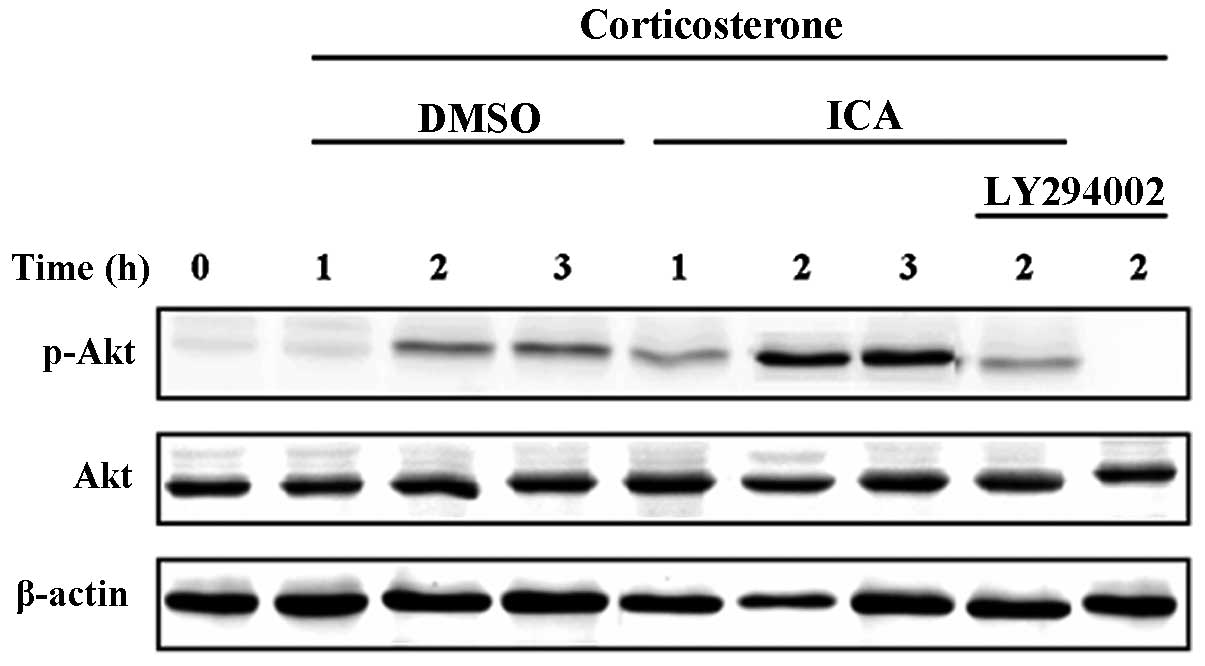Icariin inhibits corticosterone-induced apoptosis in hypothalamic neurons via the PI3-K/Akt signaling pathway
- Authors:
- Published online on: August 21, 2012 https://doi.org/10.3892/mmr.2012.1041
- Pages: 967-972
Abstract
Introduction
Depression is one of the most common types of mood disorder and is associated with significant disability and mortality. It is projected to become the second leading cause of burden of disease in 2030 (1,2). Although a number of theories have been put forward to explain the pathology of depression, including the monoamine hypothesis, the neurotransmitter receptor hypothesis and the neurotrophic factor hypothesis, the precise mechanisms underlying the depression remain unclear (3).
Considerable evidence suggests that dysregulation of the hypothalamic-pituitary-adrenal (HPA) axis is associated with depression (4,5). Hyperactivity of the HPA axis results in increased levels of the glucocorticoid hormone cortisol in depressed patients (6). Studies on the effects of excessive glucocorticoid on the brain in depression have to date focused on neuronal apoptosis. However, the majority of studies have only examined the hippocampal neurons in response to perturbed HPA-axis function, and little research has been conducted on alterations to hypothalamic neurons and the cellular and molecular basis for these changes. Previous studies have revealed that the hypothalami of mice subcutaneously implanted with corticosterone (CORT) pellets exhibited significant changes in the expression of proteins involved in cell death (7). A recent study identified that the antidepressant, sertraline, reduced depression-related behavior and decreased the number of apoptotic cells in the hypothalamus in a rat model of depression following myocardial infarction (8). Therefore, CORT-induced hypothalamic cell damage may correlate with behavioral manifestations of depression. Current antidepressants, which target monoaminergic systems, are widely available on the pharmaceutical market. However, approximately 30% of patients fail to respond to this therapy (9). Therefore, the search for novel drug targets for the treatment of major depression continues.
Recently, we reported that icariin, a biologically active purified compound from the Chinese herbal plant Epimedium sagittatum Maxim was able to reverse social defeat-induced depression-related behavior in mice, which is potentially mediated through inhibition of CORT secretion and glucocorticoid receptor (GR) downregulation (10). Furthermore, we identified that icariin markedly suppresses CORT-induced apoptosis in primary cultured rat hippocampal neurons, presumably through blockade of p38MAPK activation (11) In the present study, we aim to determine whether CORT is responsible for apoptosis in primary cultured hypothalamic neurons, and to investigate the protective effects of icariin by examining the activation of the phosphoinositide 3-kinase/protein kinase B (PI3-K/Akt) signaling pathway.
Materials and methods
Primary cultures of hypothalamic cells
The experiments were performed on Sprague-Dawley (SD) rats less than 24 h old purchased from the Shanghai Institute of the Chinese Academy of Science. This study was approved by the Fudan University experimental standards and followed the international guidelines on the ethical treatment of experimental animals. Primary cultures of dissociated hypothalamic cells were prepared according to a previously described method (12) with specific modifications. The hypothalamic tissue was dissected from neonatal SD rats, stripped of the meninges and blood vessels, and minced in Hanks’ balanced salt solution (HBSS) without Ca2+ and Mg2+. The tissue was dissociated using 0.125% trypsin (Beijing Solarbio Science and Technology Co., Ltd., Beijing, China) digestion for 15 min at 37°C and gentle titration through a series of glass pasteur pipettes. The cells were then plated on poly-L-lysine (molecular weight, 30,000–70,000; 0.1mg/ml; Sigma, St. Louis, MO, USA) coated-glass coverslips, 96-well plates, or 100 mm dishes at a density of 1×106 cell/ml and maintained at 37°C in a humidified 5% CO2 incubator. Neurons were cultured in neurobasal-A medium (Gibco BRL, Grand Island, NY, USA) and supplemented with 2% B27 supplement (Gibco BRL), 10 μl/ml penicillin-streptomycin, 2 mM glutamine (Solarbio), 5 ng/ml bovine fibroblast growth factor 2 (FGF2; R&D Systems, Minneapolis, MN, USA) and 1% fetal bovine serum (FBS). After a 24-h culture period, cultures grown in serum-free neurobasal medium yielded greater than 80% neurons, as estimated by immunocytochemical staining with antibodies against neurofilament proteins. The cultured neurons were used for in vitro studies on day 8 (DIV 8).
Drug treatment
CORT (Sigma) was initially dissolved in ethanol as a stock solution and then in culture media (final concentration of ethanol, 0.1%). Icariin (purity >99%) was purchased from the Shanghai Winherb Medical S&T Development Co., Ltd. (Shanghai, China). Eight-day primary hypothalamic neurons were washed twice with Mg2+-free, HEPES-buffered saline (HBS; 146 mM NaCl, 10 mM HEPES, 2 mM CaCl2, 5 mM KCl, 10 mM D-glucose, pH 7.4) and pretreated with different concentrations of icariin with or without 50 μM LY294002 (Sigma) for 2 h at 37°C, and then exposed to CORT for 24 h.
Assessement of cell viability and death
After exposure to various concentrations of CORT, icariin and LY294002, cell viability was determined using the 3-(4,5-dimethylthiazol-2-yl)-2,5-diphenyl (MTT) assay system (Beyotime Institute of Biotechnology, Shanghai, China) (11). Cell cytotoxicity following various treatments was evaluated by lactate dehydrogenase (LDH) release. This was acheived using a Quantitative Detection kit according to the manufacturer’s instructions (GenMed Scientifics Inc., Arlington, MA, USA) (11).
Cell morphology evaluation
To evaluate the morphological changes in primary cultures of hypothalamic cells, cultures were observed under a Leica DFIL inverted microscope with a phase-contrast optic lens. Images were captured using Leica QWin plus 3 Image Processing Software (Media Cybernetics, Silver Spring, MD, USA) through a Leica DFC300 FX camera device. We analyzed neurite preference from five images per condition.
Measurement of caspase-3 activity
Caspase-3 activity in primary cultures of hypothalamic lysate was determined using the Chemicon caspase colorimetric activity assay kit according to the manufacturer’s instructions (11). In brief, treated cells were resuspended in 50 μl of cell lysis buffer and incubated on ice for 30 min. After centrifugation for 5 min at 10,000 × g, the supernatant was transferred to a fresh tube followed by the addition of reaction buffer and caspase-3 substrate for 4 h at 37°C in the dark. The free chromophore p-nitroaniline (pNA) was quantified using a microtiter plate reader at 405 nm. The fold increase in caspase-3 activity was determined by comparing the absorbance from each sample with untreated neurons.
Determination of mitochondrial membrane potential (MMP)
Following treatment, hypothalamic cell cultures grown on 96-well plates were loaded with Rhodamine 123 (Rho 123) (10 μM) (Beyotime Institute of Biotechnology, Shanghai, China) at 37°C in the dark for 15 min and then washed 3 times with phosphate-buffered saline (PBS). The cell fluorescence intensity of Rho 123 was quantified using a fluorescence microplate reader (TECAN Infinite 200 microplate reader; Tecan Trading AG, Männedorf, Switzerland) with excitation at 485 nm and emission at 530 nm. The background fluorescence signal of Rho 123 was determined without cells and subtracted from those obtained in hypothalamic neurons.
Analysis of intracellular reactive oxygen species (ROS)
Intracellular ROS levels were analyzed by H2DCF-DA assay according to the method previously described (13). Cells (1×106 cells/well) were rinsed with Kreb’s ringer solution and 10 mM H2DCF-DA was added. After 15 min incubation at 37°C, cells were washed with PBS, harvested and pelleted by centrifugation and then resuspended in 0.5 ml PBS. Fluorescence intensity was then monitored using a fluorescence microplate reader. The data was analyzed and expressed as a percentage of the control. DCF labeled cells were observed under fluorescence microscopy.
Measurement of antioxidant enzyme activities
Following treatment, the cultures were washed twice with PBS, then placed into ice-cold PBS (0.1 M, containing 0.05 mM EDTA) and homogenized. The homogenate was then centrifuged at 4°C at 10,000 × g for 30 min, after which the protein concentration was determined using the Bradford method, using bovine serum albumin (BSA) as a reference standard. Measurement of superoxide dismutase (SOD) activity was performed according to the reagent kit manufacturer’s instructions.
Western blot analysis
Following treatment, cells in each of the 6-well plates were rinsed twice with cold PBS, followed by the addition of cell lysis buffer containing 150 mM NaCl, 50 mM Tris-HCl, 5 mM EDTA, 1% Nonidet P-40, 0.5% deoxycholate, 1% SDS with proteinase inhibitor cocktail (Sigma) on ice for 15 min, and then centrifuged for 20 min at 12,000 × g. The supernatant was collected and the protein concentration was measured using the Bradford method. Fifty milligrams of total protein was dissolved in sample buffer and heated for 5 min prior to loading onto polyacrylamide gels. Proteins were then transferred to poly(vinylidine difluoride) filter membranes, and blocked with 5% non-fat dry milk in Tris-buffered saline/0.05% Tween-20. The membrane was incubated with a monoclonal antibody against phospho-Akt (Ser473), Akt (Santa Cruz Biotechnology Inc., Santa Cruz, CA, USA), followed by incubation with horseradish peroxidase-conjugated (HRP) secondary antibodies and visualized using an enhanced chemiluminescence kit.
Statistical analysis
All data are expressed as the mean ± SD. Differences between groups without particular comments were generally examined for statistical significance using one-way ANOVA analysis with a post-hoc Dunnett’s test. P≤0.05 indicated a statistically significant difference.
Results
Icariin protects hypothalamic neurons against CORT-induced cytotoxicity
Cultured hypothalamic neurons were exposed to an increasing concentration of CORT (0.01–5 μM) for 24 h and cell viability was assessed using an MTT reduction assay. CORT induced cell death in a concentration-dependent manner (Fig. 1A). Exposure to CORT (1 μM) for 24 h was used for inducing excitotoxic neuronal injury in the subsequent experiments.
To investigate the neuroprotective effects of icariin on CORT-induced neuronal damage, hypothalamic neurons were pretreated with icariin at 0.1 μM and 1 μM for 2 h, followed by challenge with CORT (1 μM) for 24 h. Icariin pretreatment at 0.1 μM and 1 μM enhanced cell viability compared with the CORT-treated control (Fig. 1B). The protective effect of icariin on CORT-induced cytotoxicity was also analyzed using the LDH test. Pretreatment with 0.1 μM and 1 μM icariin caused a marked decrease in LDH release (Fig. 1C).
Icariin suppresses hypothalamic neuronal apoptosis induced by CORT
Morphological analysis at the subcellular level remains the most conclusive method for distinguishing apoptosis from necrosis. The protective effect of icariin on CORT-induced cytotoxicity was also analyzed by microscopic examination. Cultured hypothalamic neurons were pretreated with or without 1 μM icariin for 2 h, followed by challenge with CORT (1 μM) for 24 h. Cells treated with vehicle were healthy with networks of neurites and vacuole-free cell bodies. The synapse connections between neurons were clearly observed. Neurite fragmentation, shrinkage of cell bodies and evident cell loss were observed when the neuronal culture was exposed to 1 μM CORT for 24 h. Pretreatment of icariin with 1 μM was able to protect cortical neurons against CORT toxicity as demonstrated by the fine morphology (Fig. 2A).
Biochemical markers for caspase-3 activation following treatment with CORT were consistent with apoptotic cell death. Following 24-h CORT treatment, caspase-3 activity increased in the hypothalamic neurons. In the cultured hypothalamic neurons exposed to 1 μM CORT plus 1 μM icariin, caspase-3 activity was similar to that the of the control (Fig. 2B)
Mitochondria are recognised to be involved in apoptosis. Permeability changes can lead to caspase-dependent cytotoxicity and downstream apoptotic signaling, while a loss of mitochondrial transmembrane potential, denoted as mitochondrial dysfunction, leads to cytochrome c release from the mitochondria and triggers other apoptotic factors. In the present study, we evaluated mitochondrial transmembrane potential using Rho 123 as fluorescent dye. Dye distribution was examined under inverted microscope (Leica DFIL). In the control cultures, Rho 123 was markedly aggregated in hypothalamic neurons, reflecting the baseline for healthy mitochondria in cells. CORT-treated neurons demonstrated a decrease in Rho 123 of 37%. Pretreatment of 1 μM, but not 0.1 μM icariin, significantly inhibited these changes (Fig. 2C and D).
Icariin inhibits intracellular accumulation of ROS and prevents loss of antioxidant enzyme activities in CORT-treated cells
To determine whether icariin attenuates cell death by blocking ROS generation, we detected the intracellular level of ROS using H2DCF-DA fluorescent dye. Treatment of hypothalamic neurons with 1 μM CORT for 24 h resulted in a significantly increased DCF signal compared with the control group, but this was significantly reduced by icariin pretreatment (Fig. 3A and B).
The level of SOD provided further evidence of the protective effects of icariin. Incubation with 1 μM CORT for 24 h resulted in a significantly decreased activity of SOD (42.5%) in the hypothalamic neurons compared to the controls. However, pretreatment with 1 μM icariin resulted in a significant increase in the activity of SOD (37.5%) when compared to cells treated with CORT. Together, these results suggest that pretreatment with icariin prevents ROS generation and attenuates changes in SOD activity induced by treatment with CORT (Fig. 3C).
Phosphorylation of Akt in CORT-treated neurons following exposure to icariin
Activation of the PI3-K/Akt signal pathway by CORT and icariin in cultured hypothalamic neurons was determined by measuring phospho-Akt levels. Neurons were pretreated with icariin or control media for 30 min followed by stimulation with CORT for 1, 2 and 3 h. Western blot analysis revealed a significant increase in phospho-Akt at 2 h following treatment with CORT in cultured hypothalamic neurons, similar levels were also recorded in the cells treated for 3 h. In the icariin-treated groups, Akt phosphorylation was increased compared with the CORT-treated control group. As expected, the cells treated with LY294002 demonstrated a significant decrease in the amount of phosphorylated Akt at 2 h (Fig. 4).
Discussion
The present study demonstrates that icariin prevents CORT-induced apoptosis in primary cultured hypothalamic neurons. Exposure of hypothalamic neurons to CORT resulted in a significant loss of viability and apoptosis of the cells. In parallel, CORT significantly increased the intracellular ROS elevation and decreased SOD activity. However, pretreatment of the cells with icariin prior to CORT exposure noticeably suppressed these CORT-induced cellular events. Furthermore, icariin is able to prevent CORT-induced hypothalamic cell death via activation of the PI3-K/Akt pathway.
Patients with major depression and other neurological afflictions frequently display hyperactivity of the HPA axis (14). Patients with major depression are known to have a higher level of cortisol than patients without major depression (15). In rodents, studies have revealed that repeated CORT injections induce behavioral and neurochemical aspects of depression (16). For example, chronic CORT injections increased the immobility time on the forced swimming test (17). Several studies have demonstrated that glucocorticoids induce atrophy of dendritic processes, inhibition of neurogenesis and cause overt loss of neurons by necrosis or apoptosis of the hippocampus (18–20). Our recent study also revealed that CORT may induce hippocampal neuronal damage (11). In the present study, we observed morphological changes, including displayed neurite fragmentation, shrinkage of cell bodies and evident cell loss in hypothalamic neurons following CORT treatment. Furthermore, our results demonstrated that exposure to CORT significantly decreased MMP and increased caspase-3 activity. These results are consistent with previous studies that the hypothalami of mice implanted with CORT pellets exhibited significant changes in proteins related to cell death pathways (7).
Several studies have demonstrated that ROS may lead to neuronal apoptosis in neurodegenerative disorders (21). ROS is a natural by-product of the normal metabolism of oxygen in the mitochondria, and accumulation of ROS may be related to mitochondrial dysfunction and the induction of apoptosis (22). However, the antioxidant enzymes of SOD play protective roles in all aerobic organisms by scavenging the generation of free radical molecules. An imbalance between the generation of free radicals and antioxidants may be involved in the pathogenesis of most neurodegenerative diseases. In agreement with previously reported results, our study demonstrated that CORT induces ROS generation and suppresses SOD activity. The results suggest ROS are involved in CORT-induced cytotoxicity.
The involvement of the PI3-K/Akt signal pathway in neuronal survival involves different mechanisms. To identify the intracellular signaling pathways that mediate the neuroprotective actions of icariin, changes in the phosphorylation of key signaling proteins were analyzed by immunoblots with phospho-specific antibodies. In the present study, neurons were pretreated with icariin or control media for 30 min followed by stimulation with CORT for 1, 2 and 3 h. Western blot analysis revealed an increase in phospho-Akt at 2 h following treatment with CORT in cultured hypothalamic neurons and these levels of phospho-Akt were sustained for at least 3 h. This is consistent with previous studies that revealed CORT increases the phosphorylation of PI3-K/Akt in neurons grown in neurobasal medium supplemented with B27 and 500 μm L-glutamine (NBM+) (23). In the icariin-treated groups, Akt phosphorylation was increased compared with the CORT-treated control group. As expected, the cells treated with LY294002 demonstrated a significant decrease in the amount of phosphorylated Akt at 2 h. In addition, pretreatment with LY294002 significantly blocked the neuroprotective effects of icariin against CORT-induced apoptosis. These results suggest that icariin is able to prevent neuronal cell death induced by CORT in hypothalamic neurons by modulating the activity of the PI3-K/Akt pathway.
In conclusion, icariin was identified to be able to prevent CORT-induced hypothalamic cell death via activation of the PI3-K/Akt pathway. This study not only demonstrates the potential pharmacological uses of icariin, but also reveals the key neuroprotective role of the PI3-K/Akt pathway.
Acknowledgements
This study was supported by a grant from the National Basic Science Program of China (No. 2009CB523000) and the National Natural Science Foundation of China (No. 81102562).
Abbreviations:
|
CORT |
corticosterone |
|
PI3-K/Akt |
phosphoinositide 3-kinase/protein kinase B |
|
MTT |
3-(4,5)-dimethylthiahiazo(-z-y1)-3,5-di-phenytetrazoliumromide |
|
LDH |
lactate dehydrogenase |
|
ROS |
reactive oxygen species |
|
HPA |
hypothalamic-pituitary-adrenal |
|
ICA |
icarrin |
|
GR |
glucocorticoid receptor |
|
MAPK |
mitogen-activated protein kinases |
|
Rho 123 |
rhodamine 123 |
|
MMP |
mitochondrial membrane potential |
|
SOD |
superoxide dismutase |
References
|
Mathers CD and Loncar D: Projections of global mortality and burden of disease from 2002 to 2030. PLoS Med. 3:e4422006. View Article : Google Scholar : PubMed/NCBI | |
|
Ustun TB, Ayuso-Mateos JL, Chatterji S, Mathers C and Murray CJ: Global burden of depressive disorders in the year 2000. Br J Psychiatry. 184:386–392. 2004.PubMed/NCBI | |
|
Chopra K, Kumar B and Kuhad A: Pathobiological targets of depression. Expert Opin Ther Targets. 15:379–400. 2011. | |
|
Pariante CM and Lightman SL: The HPA axis in major depression: classical theories and new developments. Trends Neurosci. 31:464–468. 2008. View Article : Google Scholar : PubMed/NCBI | |
|
Snyder JS, Soumier A, Brewer M, Pickel J and Cameron HA: Adult hippocampal neurogenesis buffers stress responses and depressive behaviour. Nature. 476:458–461. 2011. View Article : Google Scholar : PubMed/NCBI | |
|
Pariante CM: Risk factors for development of depression and psychosis. Glucocorticoid receptors and pituitary implications for treatment with antidepressant and glucocorticoids. Ann NY Acad Sci. 1179:144–152. 2009. View Article : Google Scholar : PubMed/NCBI | |
|
Skynner HA, Amos DP, Murray F, et al: Proteomic analysis identifies alterations in cellular morphology and cell death pathways in mouse brain after chronic corticosterone treatment. Brain Res. 1102:12–26. 2006. View Article : Google Scholar | |
|
Wann BP, Bah TM, Kaloustian S, et al: Behavioural signs of depression and apoptosis in the limbic system following myocardial infarction: effects of sertraline. J Psychopharmacol. 23:451–459. 2009. View Article : Google Scholar : PubMed/NCBI | |
|
Kulkarni SK and Dhir A: Current investigational drugs for major depression. Expert Opin Investig Drugs. 18:767–788. 2009. View Article : Google Scholar : PubMed/NCBI | |
|
Wu J, Du J, Xu C, et al: Icariin attenuates social defeat-induced down-regulation of glucocorticoid receptor in mice. Pharmacol Biochem Behav. 98:273–278. 2011. View Article : Google Scholar : PubMed/NCBI | |
|
Liu B, Zhang H, Xu C, et al: Neuroprotective effects of icariin on corticosterone-induced apoptosis in primary cultured rat hippocampal neurons. Brain Res. 1375:59–67. 2011. View Article : Google Scholar : PubMed/NCBI | |
|
Yokosuka M, Ohtani-Kaneko R, Yamashita K, Muraoka D, Kuroda Y and Watanabe C: Estrogen and environmental estrogenic chemicals exert developmental effects on rat hypothalamic neurons and glias. Toxicol In Vitro. 22:1–9. 2008. View Article : Google Scholar : PubMed/NCBI | |
|
Wang H, Xu Y, Yan J, et al: Acteoside protects human neuroblastoma SH-SY5Y cells against beta-amyloid-induced cell injury. Brain Res. 1283:139–147. 2009. View Article : Google Scholar : PubMed/NCBI | |
|
Kunugi H, Hori H, Adachi N and Numakawa T: Interface between hypothalamic-pituitary-adrenal axis and brain-derived neurotrophic factor in depression. Psychiatry Clin Neurosci. 64:447–459. 2010. View Article : Google Scholar : PubMed/NCBI | |
|
Keller J, Flores B, Gomez RG, et al: Cortisol circadian rhythm alterations in psychotic major depression. Biol Psychiatry. 60:275–281. 2006. View Article : Google Scholar : PubMed/NCBI | |
|
Iijima M, Ito A, Kurosu S and Chaki S: Pharmacological characterization of repeated corticosterone injection-induced depression model in rats. Brain Res. 1359:75–80. 2010. View Article : Google Scholar : PubMed/NCBI | |
|
Ago Y, Arikawa S, Yata M, et al: Antidepressant-like effects of the glucocorticoid receptor antagonist RU-43044 are associated with changes in prefrontal dopamine in mouse models of depression. Neuropharmacology. 55:1355–1363. 2008. View Article : Google Scholar : PubMed/NCBI | |
|
Gerritsen L, Comijs HC, van der Graaf Y, Knoops AJ, Penninx BW and Geerlings MI: Depression, hypothalamic pituitary adrenal axis, and hippocampal and entorhinal cortex volumes - The SMART Medea Study. Biol Psychiatry. 70:373–380. 2011. | |
|
de Quervain DJ, Aerni A, Schelling G and Roozendaal B: Glucocorticoids and the regulation of memory in health and disease. Front Neuroendocrinol. 30:358–370. 2009.PubMed/NCBI | |
|
Xu Y, Zhang C, Wang R, et al: Corticosterone induced morphological changes of hippocampal and amygdaloid cell lines are dependent on 5-HT7 receptor related signal pathway. Neuroscience. 182:71–81. 2011. View Article : Google Scholar | |
|
Fatokun AA, Stone TW and Smith RA: Oxidative stress in neurodegeneration and available means of protection. Front Biosci. 13:3288–3311. 2008. View Article : Google Scholar : PubMed/NCBI | |
|
Huang SH, Lin CM and Chiang BH: Protective effects of Angelica sinensis extract on amyloid beta-peptide-induced neurotoxicity. Phytomedicine. 15:710–721. 2008. View Article : Google Scholar : PubMed/NCBI | |
|
Zhu ZH, Yang R, Fu X, Wang YQ and Wu GC: Astrocyte-conditioned medium protecting hippocampal neurons in primary cultures against corticosterone-induced damages via PI3-K/Akt signal pathway. Brain Res. 1114:1–10. 2006. View Article : Google Scholar |













